“‘But the Fountain Sprang Up and the Bird Sang Down’: Heidegger’s Gathering of the Fourfold and the Seven-Sacraments Font at Salle, Norfolk.”
Abstract
:1. Prolegomenon
“FONT. On two steps. The inscription records the donor, who died in 1437. The figures on the base have been chopped off. Against the bowl the Seven Sacraments and the Crucifixion.FONT COVER. A very tall Perp canopy. Not completely preserved, but very impressive with the remaining fin-like radially set members. The PULLEY on its big arm also survives and is connected with the balcony in the tower”.
“An interior of immense height and volume frames the crockets of an elegant font cover. This is suspended from a huge bracket projecting from the bell-ringers gallery in the tower, both embellished with tracery. Beneath this cover rests one of the best Seven-Sacraments fonts in Norfolk, its panels excellently preserved. Beneath each scene is a small angel holding the symbol of the sacrament above, such as the scourge as symbol of penance”.
“The cover retains traces of original paint, but has lost all the carved work that slid into the grooves that can still be seen in the fretwork. The subjects on the carved panels of the Seven Sacrament font, beginning at the south west corner are: Communion, Ordination, Baptism, Confirmation, Penance, Matrimony, Holy Unction. The eighth panel, facing the west door, is of the Crucifixion. Original paint remains on the crane for lifting the font cover and on most of the ringing gallery rail”.
2. Dwelling—A Breviary
2.1. Earth
2.2. Sky
2.3. The Divinities
2.4. The Mortals
3. Alètheia
3.1. The Threshold
Doorway with a quatrefoil band up the jambs and arch. Two angels in the spandrels. A frieze of shields above it and three niches around it.
3.2. The Clearing
3.3. The Risers
3.4. The Stem
- Who then made strong the fountains and made fresh the
- springs
- Made cool the dry rock and made firm the sand […]
- restoring with a new verse the ancient rhyme […]
- But the fountain sprang up and the bird sang down37
- Redeem the time, redeem the dream.
- … where the sun beats,
- And the dead tree gives no shelter, the cricket no relief,
- And the dry stone no sound of water…
- Here is no water but only rock
- Rock and no water and the sandy road […]
- If there were water we should stop and drink […]
- If there were the sound of water only.
3.5. The Cup (Exterior)
3.6. The Bowl (Interior)
3.7. The Water
3.8. The Cover
4. Exegesis
Funding
Institutional Review Board Statement
Informed Consent Statement
Data Availability Statement
Conflicts of Interest
| 1 | And, more than that, that it is specifically by isolating and dividing something into its smallest component parts that we can learn most about it, including its purpose and meaning. Cf. Descartes’ infamous vivisections as attempts to understand the vascular system or, even more preposterously, life itself. |
| 2 | Heidegger’s term for encountered things was “ready-to-hand-equipment.”. |
| 3 | Heidegger was himself criticized on this very score by Meyer Shapiro who claimed that while Heidegger thought Van Gogh’s painting of a pair of peasant shoes told an intersubjectively and non-reflectively perceptible “truth about the world” (299) he was in fact himself simply projecting his own thoughts and feelings onto the painting. Shapiro feels that Heidegger has deceived himself in supposing that the truth of this painting is something given here once and for all, especially without taking the artist’s own motivation and presence in the work into account. “The Still Life as a Personal Object: A Note on Heidegger and Van Gogh” (Shapiro 1968, pp. 296–300). |
| 4 | Although one could argue that the question isn’t really one of simple accuracy or inaccuracy—this way of considering things is in itself part of a reductionist and unnecessarily dichotomous way of perceiving things. It is rather that poetic, ekphrastic saying, the way Heidegger conceives of it, has access to a deeper reality and fuller truth (Šišovski 2013, p. 3). |
| 5 | In phenomenological texts, the writer does not so much attempt to capture ‘absolute truth’ or ‘objective reality’ (shibboleths both) as aspire to capture a sense of meaning, the meaning—ultimately—of human existence (Van Manen 2017, p. 7). |
| 6 | Any original German words, phrases and passages included can be traced to (Heidegger 2000). |
| 7 | –but which can trace its ancestry all the way back to ancient Greece– |
| 8 | In the post-modern world, consumption increasingly takes the form of experiences. Historic churches are often advertised as good destinations for a ‘day out’ and parts of them either objectively evaluated as ‘worth seeing’ or removed and offered as a consumer experience elsewhere, such as in museums. Increasingly, parts are also reproduced, such as the replica brasses that members of the general public can now pay to rub at the St Peter Hungate Museum and Brass Rubbing Centre in Norwich. These are all examples of how objectification and positionality collude to position the human as the ‘greedy consumer of objectified experience.’ (Mitchell 2015, p. 32). |
| 9 | We shall return to this later in outlining the elements of the fourfold. |
| 10 | Nader El-Bizri has rightly pointed out that many adaptive assimilations of Heidegger’s thinking around the fourfold to architectural concerns must be deemed “facile or dilettante” in not having attended with due thoughtfulness to the intricacies of his philosophical pathways (El-Bizri 2011, p. 48). |
| 11 | However, while things need the ground to be grounded, the ground likewise needs things to ground in order to be grounding—and, also, to itself be grounded (Mitchell 2015, p. 76). |
| 12 | Heidegger didn’t define himself as a phenomenologist after what he referred to as the ‘turning,’ which took place after the publication of Being and Time, but phenomenology did nevertheless continue to reverberate in his thoughts and work all his life long. In his penetrating and productive parsing of the fourfold, Andrew Mitchell makes a persuasive case for the ways in which a close reading of Heidegger’s writing about the fourfold rewards one with a definite conviction of the schema being wholly phenomenological. |
| 13 | So does Heidegger’s unknown and by-default absent God, for example, appear as unknown and absent precisely through the sky’s manifestness of that absence (Mitchell 2015, pp. 124–25). |
| 14 | While Heidegger does not use the terms chronos (from which we get chronological) and kairos in the texts from which I am working, it seems obvious that his drifting clouds and his inclemencies of weather do not mean to suggest temporality as measured by clock time, but rather a kairotic time that brings to fruition each thing in its own time. |
| 15 | An ontological, existential conflation that Heidegger also famously made regarding the icons of gods, writing “The sculpture of the god…is not a portrait whose purpose is to make it easier to realise how the god looks; rather, it is a work that lets god himself be present and thus is the god himself.” (Heidegger 2013b, p. 42). |
| 16 | While the prayer “In the midst of life there is death” is often recited at funerals, in which context it is simply understood as meaning that at any given moment one person may die while another remains alive, a more profound everyday reading of it would highlight the fact that we are all always and continuously dying, or living-towards-death. |
| 17 | In English translation the passage reads: “…and indeed continually, as long as [we] remain upon the earth, under the sky, before the divinities.” “Building Dwelling Thinking” (Heidegger 2013a, p. 148). |
| 18 | In (Heidegger 1973), Heidegger wrote, “[t]hings themselves are places and do not merely belong to a place.” Jeff Malpass has similarly commented that place is something other than mere location (Heidegger 1973, p. 255). |
| 19 | Heidegger was scathing of tourists who visited but did not see, who appeared unable to perceive the traces of being (Sharr 2008, p. 13). |
| 20 | This figures prominently in the Christian belief in humankind’s life on earth being a life lived in exile. |
| 21 | While scientific measuring measures the unknown against the known, Heidegger’s poetic measuring measures the known against the unknown. |
| 22 | It has been observed that the loftiest churches and most soaring of church spires tend to be found where, as Cox would have it, “the neighbourhood is monotonously flat or destitute of striking features (Cox 1976, pp. 20–23). While in hillier and more mountainous terrain, as Wordsworth reflected in 1798: the “steep and lofty cliffs […] connect/The landscape with the quiet of the sky.” (“Tintern Abbey, Lines Composed Above”, Wordsworth 1926), that task is left to man on “duller levels” (Cox, again). |
| 23 | Jesus is quoted as having said, “Verily, verily, I say unto thee, Except a man be born of water and of the Spirit, he cannot enter into the kingdom of God. (KJV, John 3:5) |
| 24 | We know, of course, that Christian iconography owes a great deal to Rome, and it is fascinating to ponder the inherited subliminal memory that pictures, such as Classical motifs, retain when appropriated into a new context, Christian as here. Just how and when this particular elision or translation of motifs took place is not known. |
| 25 | Setting foot under a hammerbeam angel roof was to come under the guardianship of its angels (Stanford 2019, p. 187). |
| 26 | So-called because it was devised by angelologists in the 12th century as an explanation of the relationship between heaven and earth, God and humanity (or, if you like, between earth and sky, mortals and gods, to use Heidegger’s terminology) by means of angels (Stanford 2019, pp. 8, 27, 149). |
| 27 | On stepping into a church, a sacred space, the threshold does not merely separate (and join) exterior and interior, two sides of a material wall, but two modes of being, two qualitatively different spaces. Crossing into a sacred space, the threshold does not open merely inwards, but also upwards, making angels particularly apposite threshold companions (Eliade 1987, pp. 25, 26). |
| 28 | Looking from the darkness underneath the bell ringers’ gallery towards the light of the nave and the sun-infused chancel beyond visually replicates the meanings of the various parts of the church, where the west is associated with the realm of darkness, grief, and death; the middle, i.e., the nave, represents earthly life; and the sanctuary in th easternmost part represents Paradise, traditionally thought to have been in the east (Eliade 1987, p. 61). |
| 29 | Eliade defines unconsecrated space as an amorphous wasteland, an “extent into which no orientation has yet been projected, and hence in which no structure has yet arisen” (Eliade 1987, pp. 36, 64). |
| 30 | Just as the central placing of the font acts as a visual spatial reminder directly upon entry into a church, of one’s own baptism and thereby of one’s inclusion in community both earthly and divine, so do the year-round ecclesiastical celebrations act as a chronological anchor for the memory of baptism (Ben-Aryeh Debby 2013, p. 19; Schlegel 2013, p. 130). |
| 31 | The enhanced location of the baptismal font, including its repositioning in the middle axis of the nave (a placement that can be traced back to the 9th-c. plan of the Abbey of St Gall, Switzerland) and its elevation on to a platform with steps, happened around the year 1200 and corresponded with a revival of the symbolism of baptism (Schlegel 2013, pp. 131, 146). |
| 32 | (BBC 1974), archived on YouTube: www.youtube.com/watch?v=EkqY-MBPTR8 (accessed on 15 June 2021) |
| 33 | Saint Ambrose called the fountain in Eden fons vitae aeternae, identifying it not only with Christ but with sapientia (wisdom) (Underwood 1950, vol. 5, p. 47). |
| 34 | Oddly, most of the Reformational or Puritanical violence appears to have been directed at these figures. The rest of the font had perhaps been successfully plastered over in time, whereas no one had imagined that the innocuous figures of the Evangelists—hardly divisive figures in the battle between Catholics and Protestants—would have occasioned so much zealous (or purely random?) rage. |
| 35 | Another enduring tradition associates the four Evangelists with angels (Stanford 2019, p. 113). Whether this equation arose as a result of their emblems all being winged, or the wings of the emblems rather came about as a result of the pre-existing equation, I must leave unsaid. Suffice to say that the connection to baptism is twice made by means of the Evangelists—by their association with the Four Rivers of Paradise that have their source in the Fountain of Eden and by their correlation with angels who, as we have already seen, have a special role to play in the rite of baptism. |
| 36 | The association of the font with the fountain of Eden/Life places it—places every font—at the centre of the world, a place that can only ever be found in sacred and never in purely geometrical space (Eliade 1987, p. 37). |
| 37 | While the font cover at Salle does not feature a little bird at its apex, many other font covers do, including the almost equally lofty one at Salle. |
| 38 | Round or polygonal (most often octagonal) baptisteries are the rule from the fourth century onward. Well-known octagonal baptisteries include the Baptistery of St John in Florence and the Lateran Baptistery (Ben-Aryeh Debby 2013, p. 14). They are possibly modelled on Roman bath buildings, which were always round, square or octagonal, the interior being centred on a basin for the performance of the cleansing ritual (Homan 2006, p. 26; Underwood 1950, p. 43). While there are only a few octagonal fonts of late Norman date in England, almost all English fonts were made octagonal from the 13th century on. |
| 39 | For the mental image of a wildly revolving font, I am indebted to the Nobel Prize-winning Swedish poet Tomas Tranströmer (2011). In “Österjöar III” (2011: 230), he writes about the extraordinary 12th-century font in the small Gotland village of Vänge: Bilderna starkare i minnet än när man ser dem direkt, starkast/när funten snurrar i en långsam mullrande karusell i minnet.” [The images are stronger in the mind’s eye than when seen directly/strongest when the font spins in a slow rumbling carousel in the mind.] |
| 40 | According to Cox, there are 32 in total in England, whereof 19 are to be found in Norfolk (Cox 1923, p. 97), whereas Matthew Byrne has it that there are 40 in total, whereof 24 in Norfolk (Byrne 2020, p. 32). It would therefore seem that another eight were unearthed between 1923 and 2020, including five in Norfolk. |
| 41 | While there is no water in the font during my visit to Salle, the search for the essence of the font requires me to use the ekphrastic technique of describing things as seen also with the mind’s eye, evoking that which is absent as vividly as that which is present. |
| 42 | “…and darkness was upon the face of the deep. And the Spirit of God moved upon the face of the waters.” (Genesis, 1:2). “And God said, Let the waters under the heave be gathered together unto one place, and let the dry land appear. And it was so.” (Genesis 1:9). |
| 43 | From Tertullian’s De Baptismo, cited in Drewer, “Fisherman and Fish Pond”: 534. Of course, this can be interpreted to mean that were we not swimming in the pond to begin with, we wouldn’t be there to be fished to our rescue. |
| 44 | By some, including Leo the Great, deduced to have taken its course from the pierced side of Christ: “from his side there flowed forth the blood of redemption and the water of baptism (taken from his letters before AD 440 and cited in (Underwood 1950, p. 57)). |
| 45 | “fons et origo” (fountain/spring and origin), a reservoir of all the possibilities of existence. Tertullian also wrote, in De Baptismo, that “Water was the first to produce that which had life, that it might be no wonder in baptism if waters knew how to give life…” |
| 46 | Heidegger understood grace both as an ‘unwarranted bestowal’ (die Gunst) and as a ‘sparing mercy’ (die Gnade), both of which he took to define the (authentically poetical) dimension of mortal existence, comprised and defined by the relationship between beings and Being (Mitchell 2010, pp. 309, 319). |
| 47 | According to a provincial English Synod in 1236, the font was always to have a locked cover, to prevent the water from being sullied or being put to any superstitious use (Cox 1923, p. 98). |
| 48 | I am not sure why or how locks would necessarily be effective against spirits, however. |
| 49 | Amy Bloch mentions the instance of Constantine’s allegedly having been cured, by means of baptismal immersion, of the leprosy that he had been suffering as a punishment from God for his having persecuted Christians (“The Two Fonts of the Florentine Baptistery”: 93). |
| 50 | In order for a place, any place, to be sacred, it must offer a break in the homogeneity of space, link heaven and earth and put us in communication with the sky/transcendent (Eliade, The Sacred and the Profane: 33–34, 37, 58). |
| 51 | The large number of culturally Christian agnostics in England and the rest of the West are, privately and—in some cases—collectively, ongoingly searching for a for them viable and meaningful Christianity, inspired by a diverse set of influences from forms of Ur-Christianity to other world religions and philosophies as well as from the various European paganisms that once co-existed with early Christianity (Schalow 2001, pp. 137, 143). |
| 52 | Referred to as such by Heidegger in Sojourns, the journal recounting his philosophical pilgrimage to Greece, traces of whose history he found in its land, art and architecture (Tonner 2014, p. 130). |
| 53 | Heidegger was himself fond of the idea of negation as confirmation. |
| 54 | As the temple does its work simply by standing in place (Heidegger 2013b, p. 41). |
| 55 | Phenomenological accounts invariably have an, albeit sometimes unspoken, ethical dimension and mine is no different (Halling 2020). |
| 56 | The word ‘dwelling’ comes, as Heidegger elucidated, form the Old (Anglo-)Saxon word wunian, meaning ‘to be brought to peace’ (Roy 2017, p. 32). |
References
- A Quick Guide to Salle Church. 2016. Leaflet available for 30p at the church. Bought in 2016. [Google Scholar]
- Ben-Aryeh Debby, Nirit. 2013. Nel mio bel San Giovanni, fatti per loco de’battezzatori: Baptismal Fonts in Tuscany. In The Visual Culture of Baptism in the Middle Ages: Essays on Medieval Fonts, Settings and Beliefs. Edited by Harriet Sonne de Torrens and Miguel A. Torrens. Farnham: Ashgate. [Google Scholar]
- Bloch, Amy R. 2013. The Two Fonts of the Florence Baptistery and the Evolution of the Baptismal Rite in Florence, ca. 1200–1500. In The Visual Culture of Baptism in the Middle Ages: Essays on Medieval Fonts, Settings and Beliefs. Edited by Harriet Sonne de Torrens and Miguel A. Torrens. Farnham: Ashgate. [Google Scholar]
- Boetzkes, Amanda, and Aron Vinegar. 2014. Heidegger and the Work of Art History. Farnham: Ashgate. [Google Scholar]
- Byrne, Matthew. 2020. Church Fonts. Oxford: Shire Publications. [Google Scholar]
- Cerbone, David R. 2006. Heidegger and the Existential Turn. In Understanding Phenomenology. Slough: Acumen. [Google Scholar]
- Cox, John Charles. 1923. English Church Fittings, Furniture & Accessories. London: Batsford. [Google Scholar]
- Cox, John Charles. 1976. The English Parish Church. East Ardsley: E P Publishing. [Google Scholar]
- Davie, Donald. 1996. The Psalms in English. London: Penguin Classics. [Google Scholar]
- Drewer, Lois. 1981. Fisherman and Fish Pond: From the Sea of Sin to the Living Waters. The Art Bulletin 63: 533–47. [Google Scholar] [CrossRef]
- El-Bizri, Nader. 2011. Being at Home among Things: Heidegger’s Reflections on Dwelling. Environment, Space, Place 3: 47–71. [Google Scholar] [CrossRef]
- El-Bizri, Nader. 2015. On Dwelling: Heideggerian Allusions to Architectural Phenomenology. Studia UBB Philosophia 60: 5–30. [Google Scholar]
- Eliade, Mircea. 1987. Sacred Space and Making the World Sacred. In The Sacred and the Profane: The Nature of Religion. San Diego: Harcourt, Inc. [Google Scholar]
- Eliot, Thomas Stearns. 1969a. “Ash Wednesday” (1930). In The Complete Poems and Plays. London: Faber and Faber. [Google Scholar]
- Eliot, Thomas Stearns. 1969b. “The Waste Land” (1922). In The Complete Poems and Plays. London: Faber and Faber. [Google Scholar]
- Gray, Madeleine. 2013. ‘The Heavens and All the Powers Therein’: The Iconography of the Font of All Saints, Gresford, in its Political Context. In The Visual Culture of Baptism in the Middle Ages: Essays on Medieval Fonts, Settings and Beliefs. Edited by Harriet Sonne de Torrens and Miguel A. Torrens. Farnham: Ashgate. [Google Scholar]
- Halling, Steen. 2020. Phenomenology as fidelity to phenomena: Moving beyond the Van Manen, Smith, and Zahavi debate. The Humanistic Psychologist. [Google Scholar] [CrossRef]
- Heidegger, Martin. 1973. Art and Space. Translated by Charles H. Seibert. Dubuque: Loras College. [Google Scholar]
- Heidegger, Martin. 2000. Vorträge und Aufsätze. Frankfurt am Main: Vittorio Klostermann. [Google Scholar]
- Heidegger, Martin. 2013a. Building, Dwelling, Thinking. In Poetry, Language, Thought. New York: Harper Perennial. [Google Scholar]
- Heidegger, Martin. 2013b. The Origin of the Work of Art. In Poetry, Language, Thought. New York: Harper Perennial. [Google Scholar]
- Heidegger, Martin. 2013c. The Thing. In Poetry, Language, Thought. New York: Harper Perennial. [Google Scholar]
- Homan, Richard. 2006. The Art of the Sublime: Principles of Christian Art and Architecture. Farnham: Ashgate. [Google Scholar]
- Husenbeth, Frederick Charles. 1858. On Sacramental Fonts in Norfolk. Journal of the British Archaeological Association 14: 51–56. [Google Scholar] [CrossRef]
- Jenkins, Simon. 2000. England’s Thousand Best Churches. London: Penguin. [Google Scholar]
- Knott, Simon. n.d. Churches of East Anglia: Norfolk. ‘Salle’. Available online: www.norfolkchurches.co.uk/salle/salle.htm (accessed on 15 June 2021).
- Kuuliala, Jenni. 2013. Baptism and the Interaction with Supernatural Creatures in Medieval Europe. In The Visual Culture of Baptism in the Middle Ages: Essays on Medieval Fonts, Settings and Beliefs. Edited by Harriet Sonne de Torrens and Miguel A. Torrens. Farnham: Ashgate. [Google Scholar]
- Malpas, Jeff. 2006. Heidegger’s Topology: Being, Place, World. Cambridge: MIT Press. [Google Scholar]
- Malpas, Jeff. 2012. Heidegger and the Thinking of Place: Explorations in the Topology of Being. Cambridge: MIT Press. [Google Scholar]
- Martin, Annabelle. 2013. The St John Portal and Baptistery at St Stephen’s Cathedral, Sens. In The Visual Culture of Baptism in the Middle Ages: Essays on Medieval Fonts, Settings and Beliefs. Edited by Harriet Sonne de Torrens and Miguel A. Torrens. Farnham: Ashgate. [Google Scholar]
- Mitchell, Andrew J. 2010. The Exposure of Grace: Dimensionality in Late Heidegger. Research in Phenomenology 40: 309–30. [Google Scholar] [CrossRef]
- Mitchell, Andrew J. 2015. The Fourfold—Reading the Late Heidegger. Evanston: Northwestern University Press. [Google Scholar]
- Mortlock, D. P., and C. V. Roberts. 2007. The Guide to Norfolk Churches. Cambridge: The Lutterworth Press. [Google Scholar]
- Norberg-Schulz, Christian. 1983. Heidegger’s Thinking on Architecture. Perspecta: The Yale Architectural Journal 20: 61–68. [Google Scholar] [CrossRef]
- Pevsner, Nikolaus, and Bill Wilson. 2002. Norfolk I: Norwich and North-East. London: The Buildings of England, Yale University Press. [Google Scholar]
- Roy, Satarupa Sinha. 2017. Wandering to Dwell: Heidegger and the Phenomenology of Dwelling in Sebald’s The Rings of Saturn. MFS Modern Fiction Studies 63: 29–49. [Google Scholar] [CrossRef]
- Schalow, Frank. 2001. Heidegger and the Quest for the Sacred: From Thought to the Sanctuary of Faith. Berlin: Kluwer Academic Publisher. [Google Scholar]
- Schlegel, Silvia. 2013. Festive Vessels or Everyday Fonts? New Considerations on the Liturgical Functions of Medieval Baptismal Fonts in Germany. In The Visual Culture of Baptism in the Middle Ages: Essays on Medieval Fonts, Settings and Beliefs. Edited by Harriet Sonne de Torrens and Miguel A. Torrens. Farnham: Ashgate. [Google Scholar]
- Shapiro, Meyer. 1968. The Still Life as a Personal Object—A Note on Heidegger and van Gogh. Deconstruction and the Limits of Interpretation 1968: 296–300. [Google Scholar]
- Sharr, Adam. 2008. Heidegger for Architects. London: Routledge. [Google Scholar]
- Šišovski, Jordan. 2013. Martin Heidegger on Poetic Dwelling. Blesok, 92. Available online: http://blesok.mk/en/literature/martin-heidegger-on-poetic-dwelling-92/ (accessed on 15 June 2021).
- Sonne de Torrens, Harriet M. 2013. Reconsidering the Date of the Baptismal Font in San Isidoro, Léon, Spain. In The Visual Culture of Baptism in the Middle Ages: Essays on Medieval Fonts, Settings and Beliefs. Edited by Harriet Sonne de Torrens and Miguel A. Torrens. Farnham: Ashgate. [Google Scholar]
- Stanford, Peter. 2019. Angels: A Visible and Invisible History. London: Hodder and Stoughton. [Google Scholar]
- Tonner, Philip. 2014. Art, Materiality, and the Meaning of Being: Heidegger on the Work of Art and the Significance of Things. In Heidegger and the Work of Art History. Edited by Amanda Boetzkes and Aron Vinegar. Farnham: Ashgate. [Google Scholar]
- Tranströmer, Tomas. 2011. Östersjöar III,” Dikter och prosa 1954–2004. Stockholm: Albert Bonniers Förlag. [Google Scholar]
- Underwood, Paul A. 1950. The Fountain of Life in Manuscripts of the Gospels. Dumbarton Oaks Papers 5: 42–138. [Google Scholar] [CrossRef]
- Van Manen, M. 2017. Writing Phenomenologically. In Writing in the Dark: Phenomenological Studies in Interpretive Inquiry. London: Routledge. [Google Scholar] [CrossRef]
- Wordsworth, William. 1926. Tintern Abbey, Lines Composed Above, (1798). In The Poetical Works of William Wordsworth. Oxford: Oxford University Press. [Google Scholar]
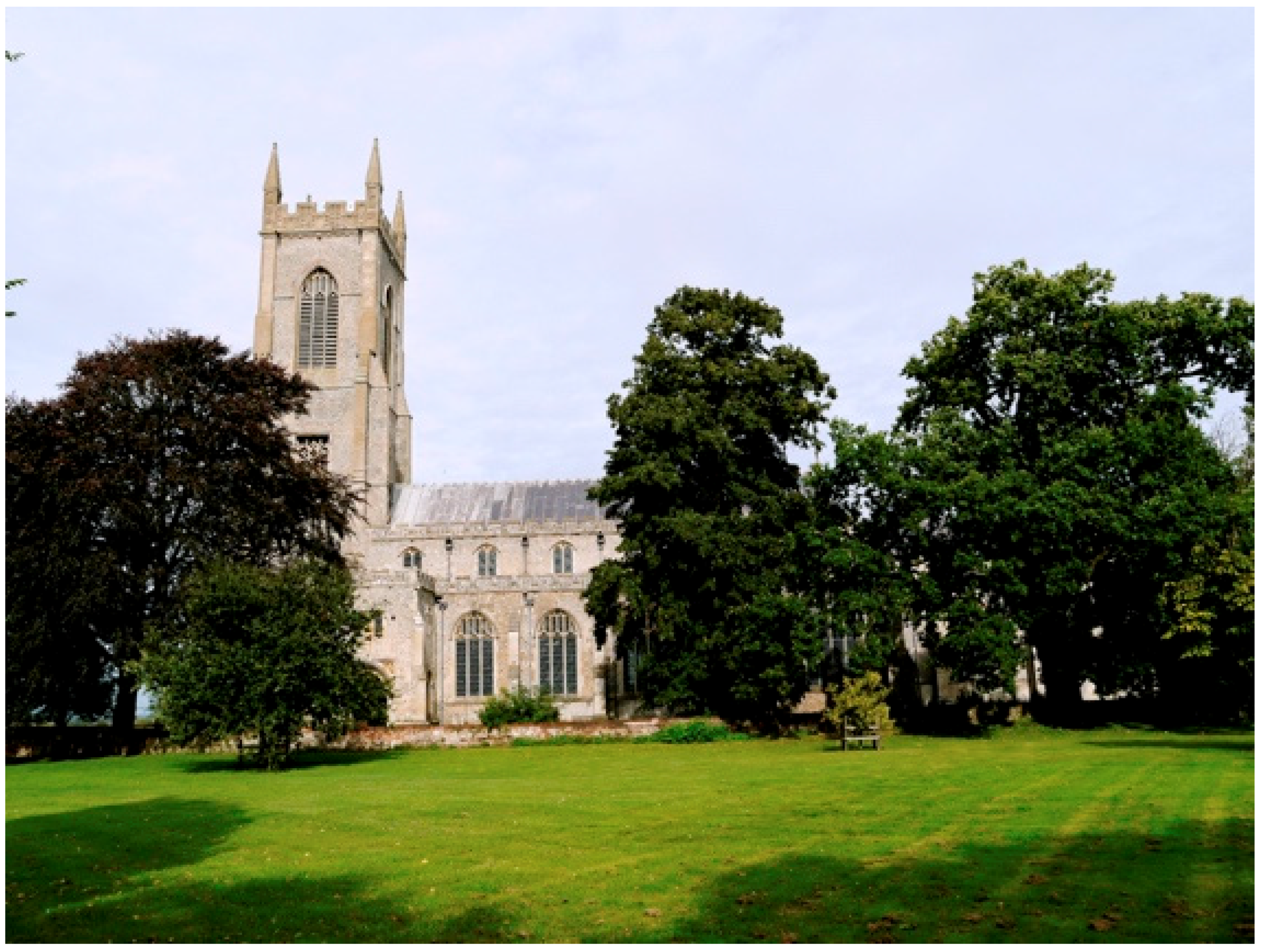
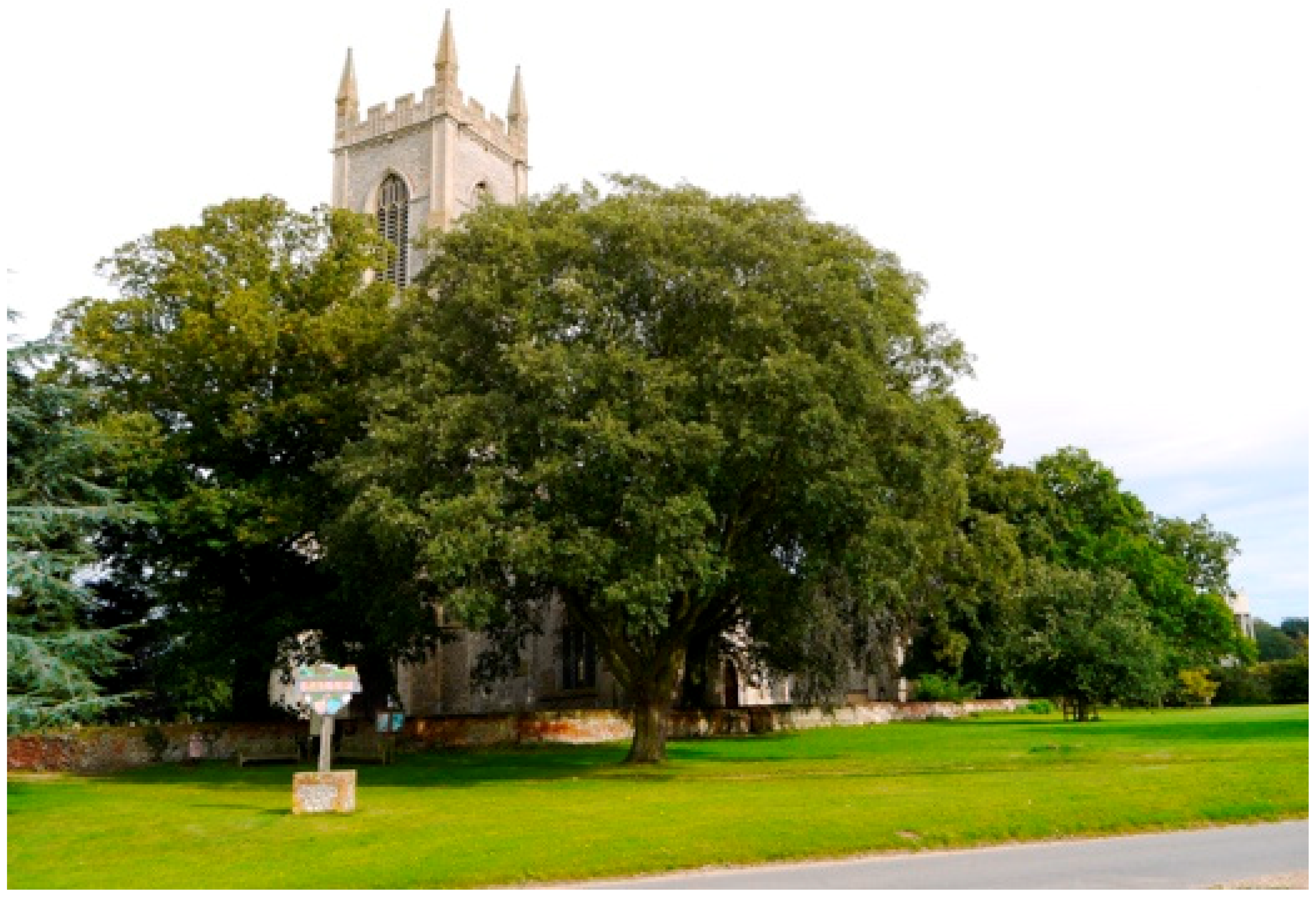
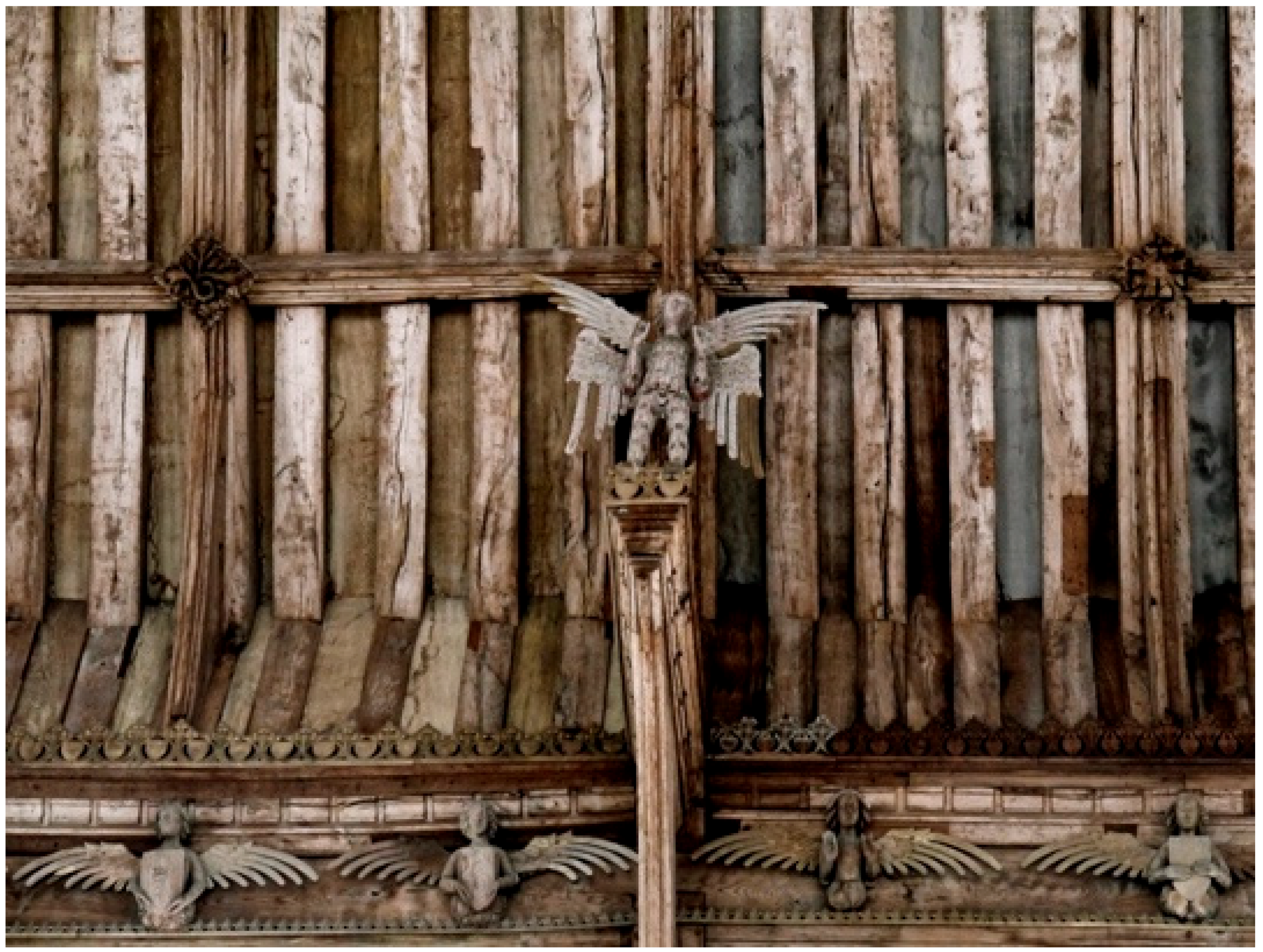
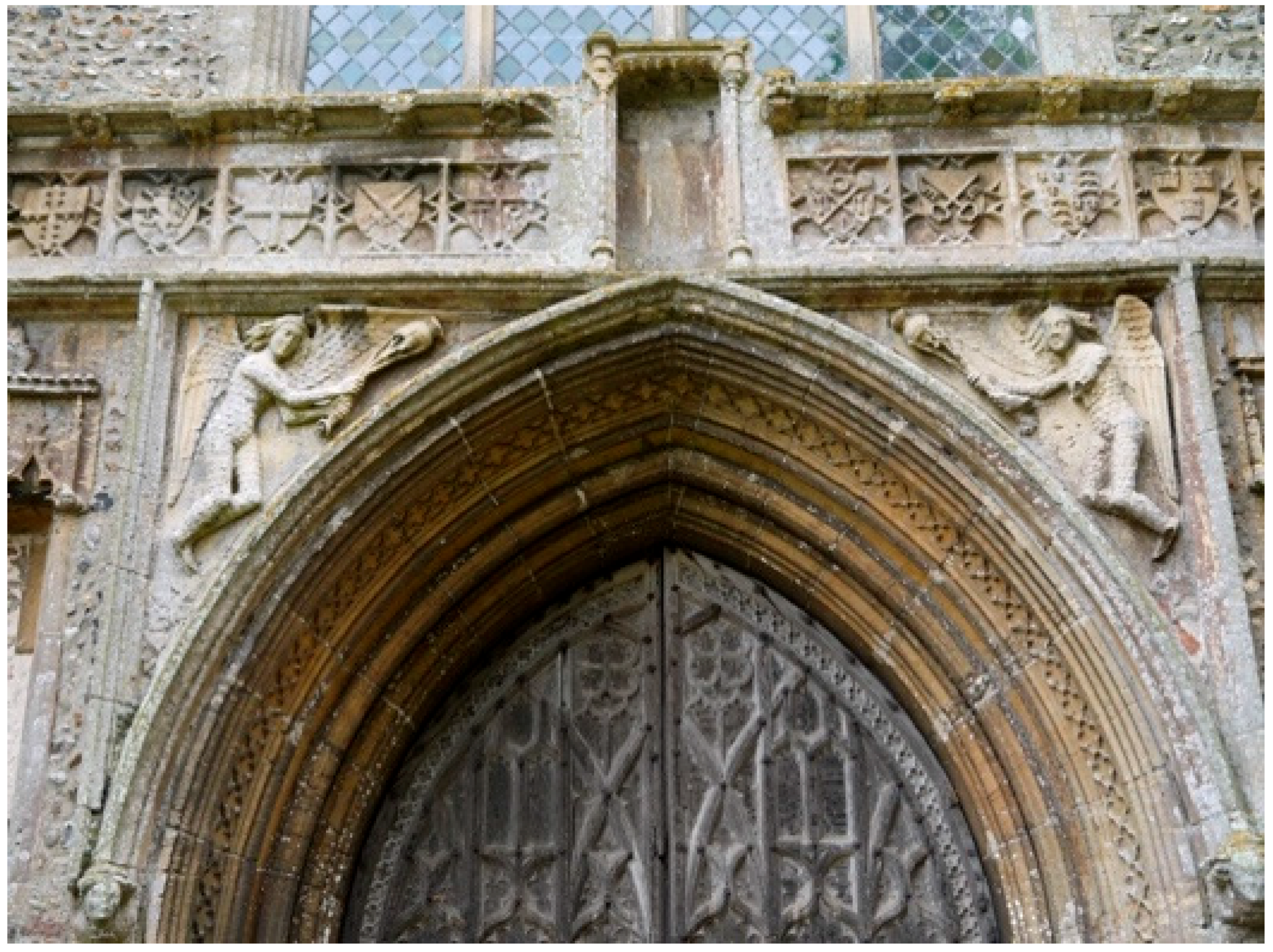
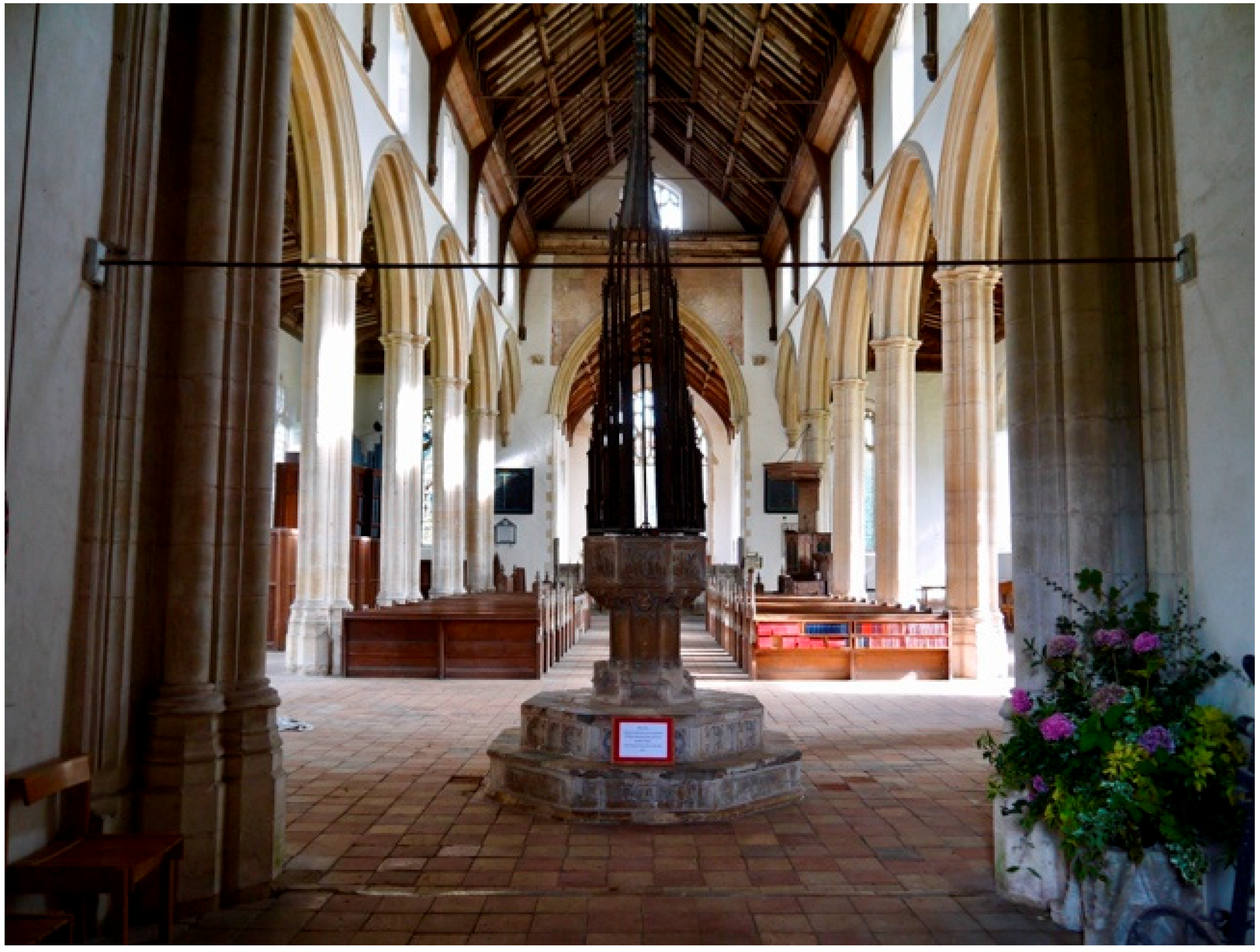
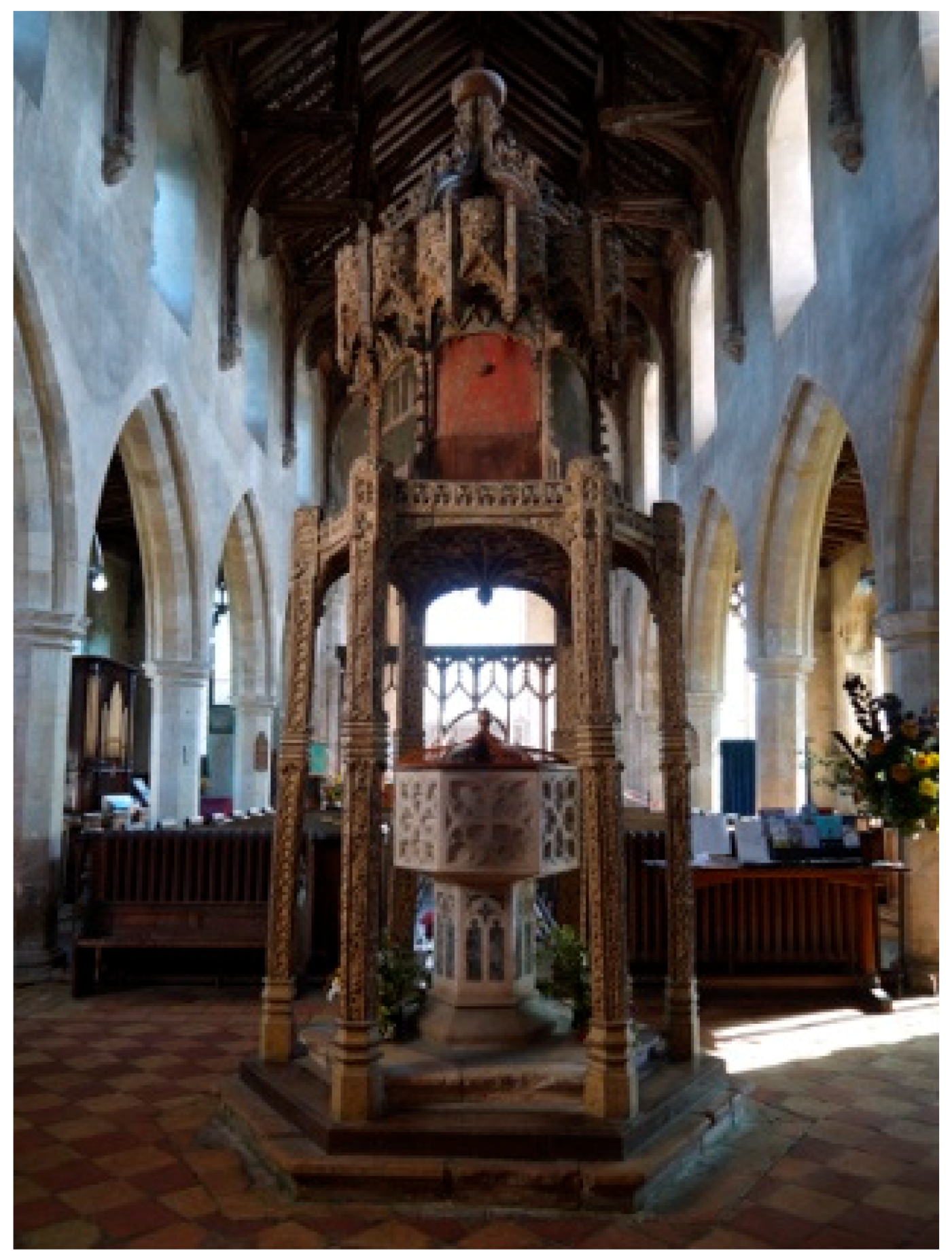
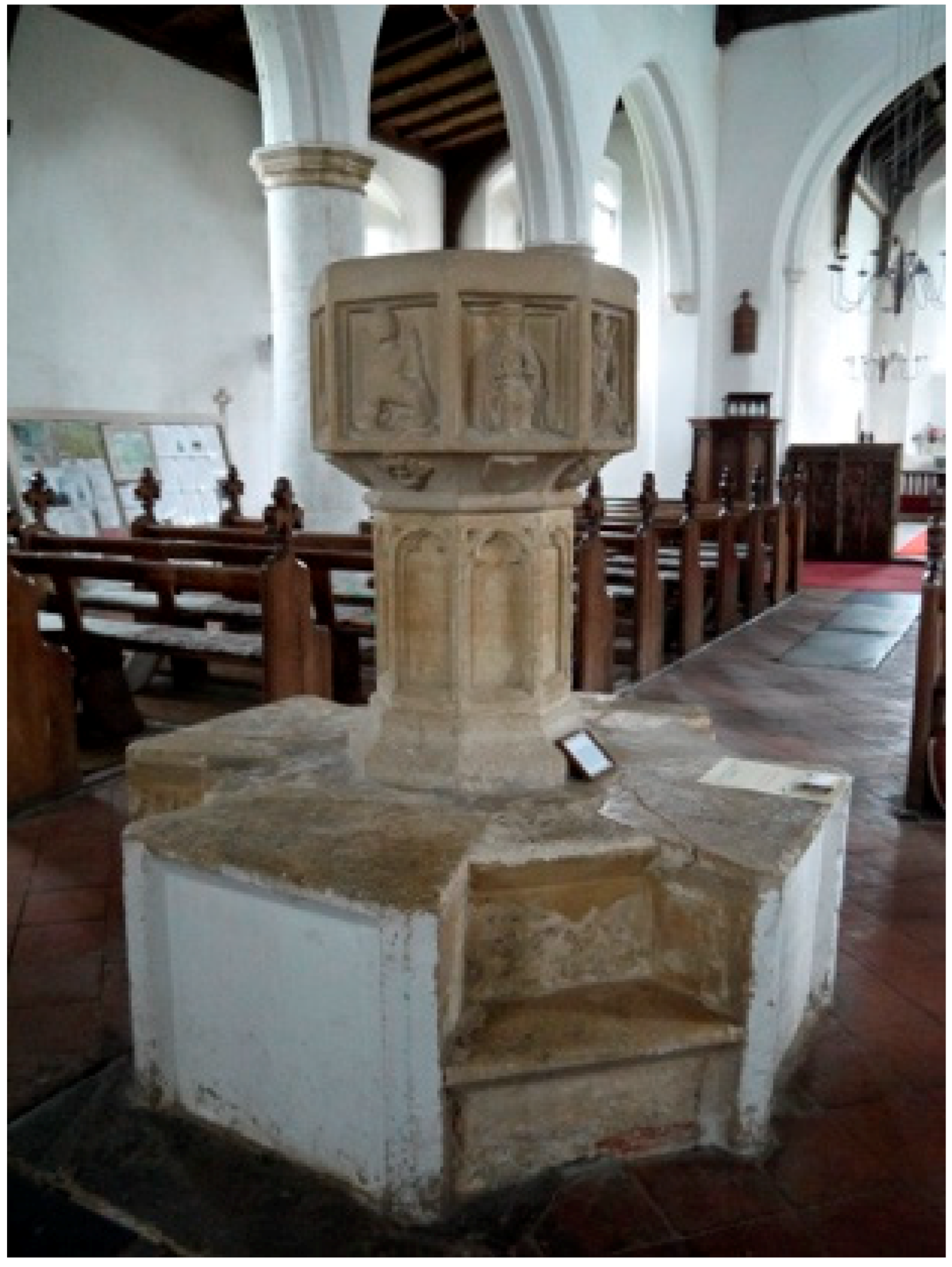
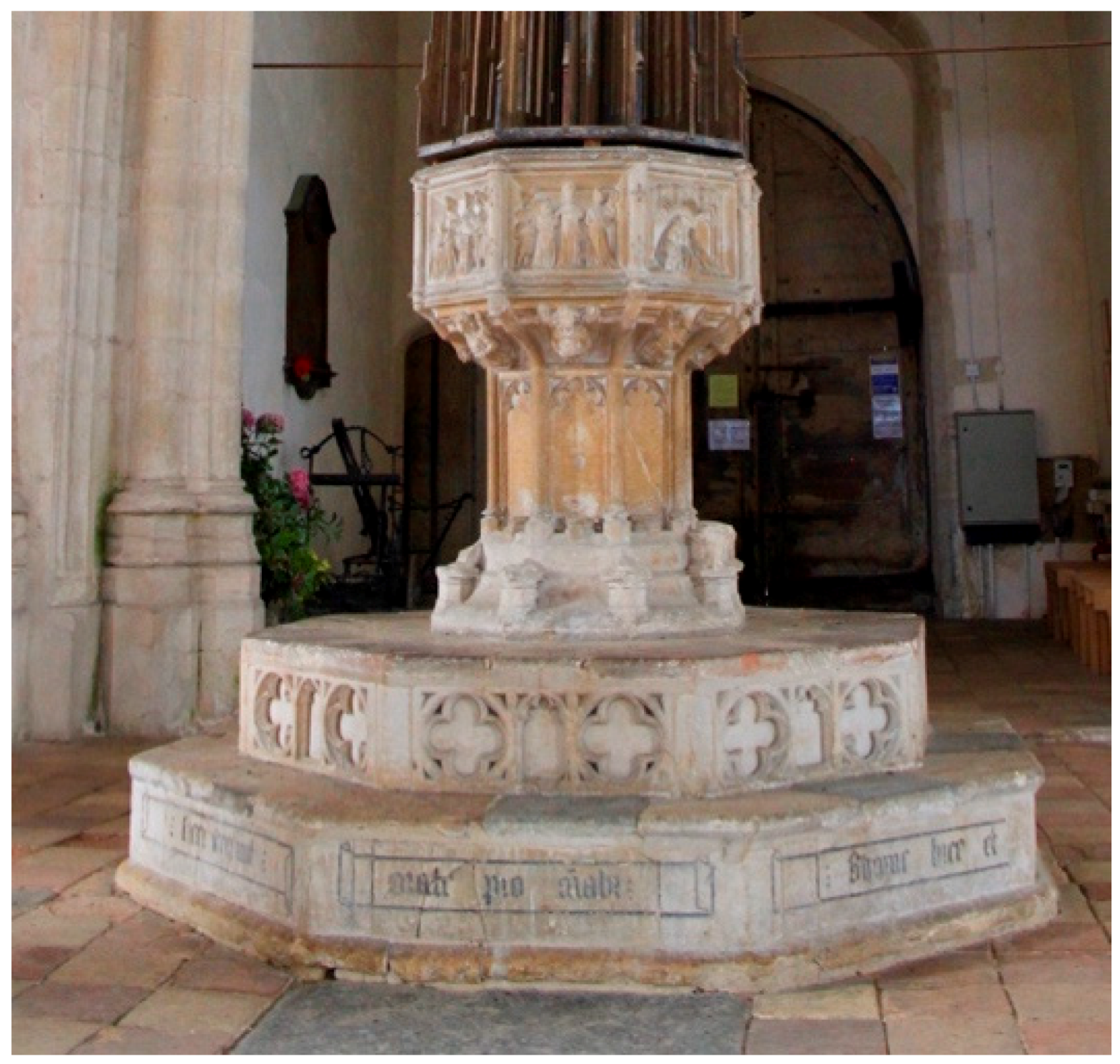
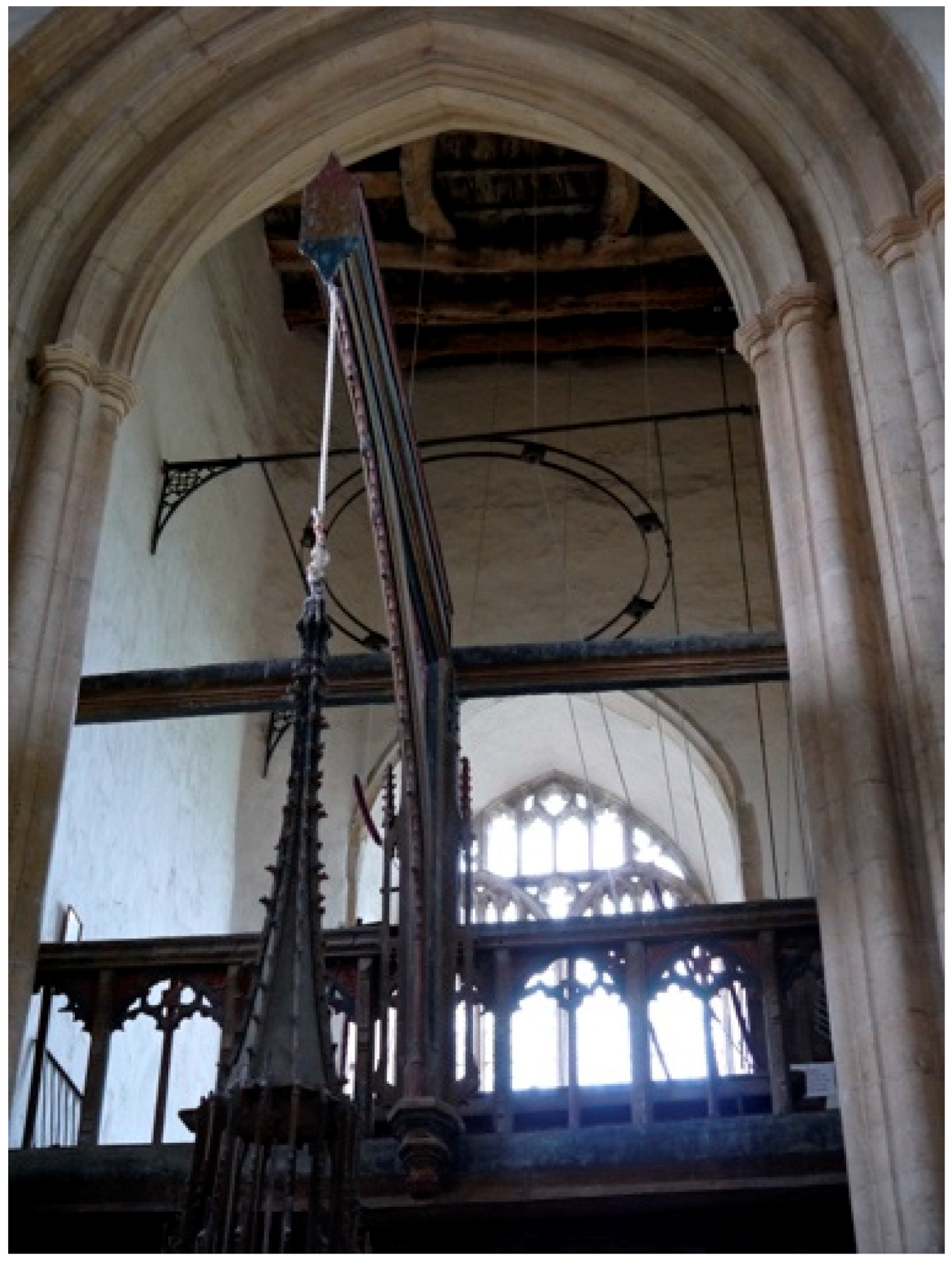
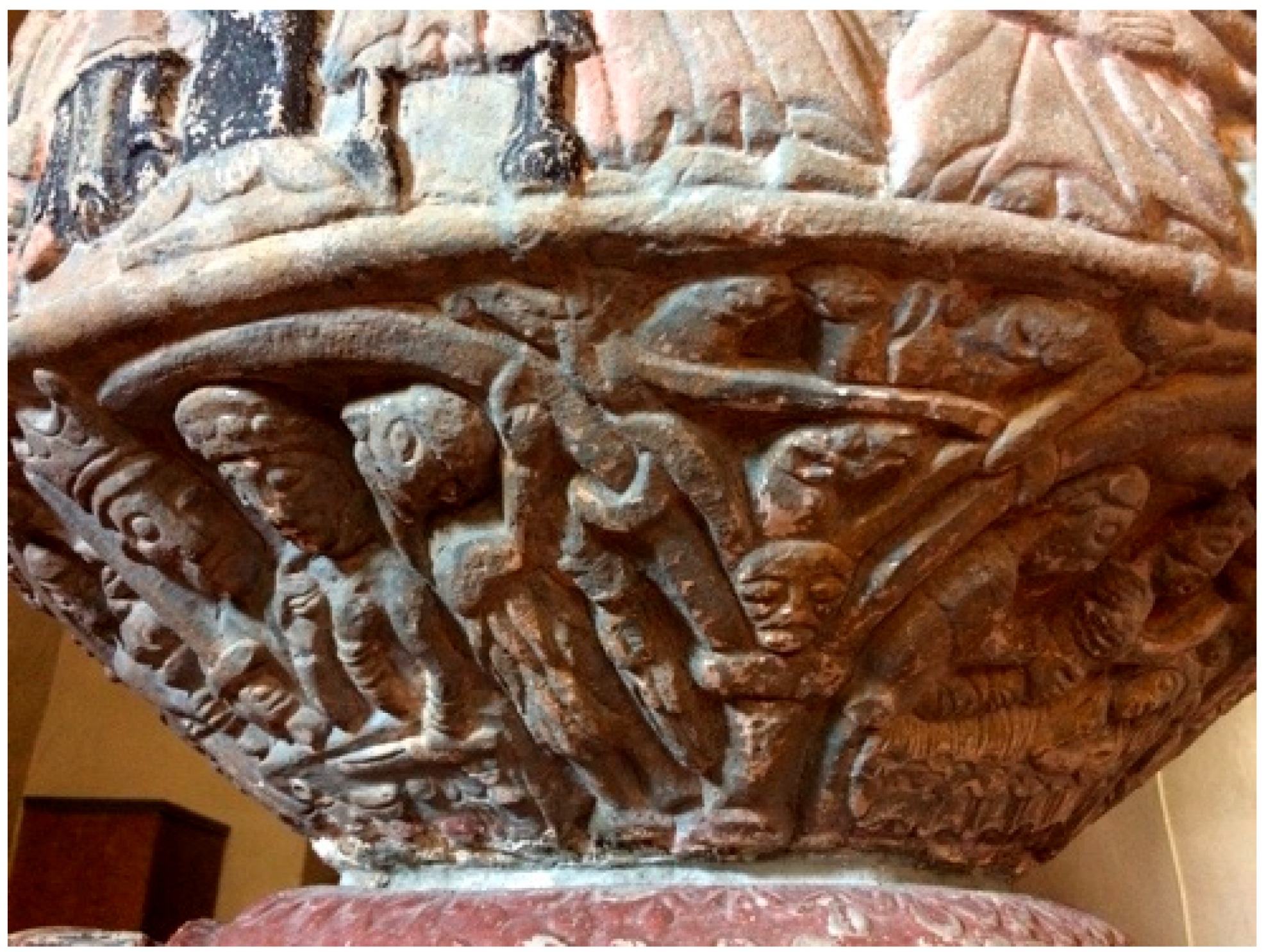
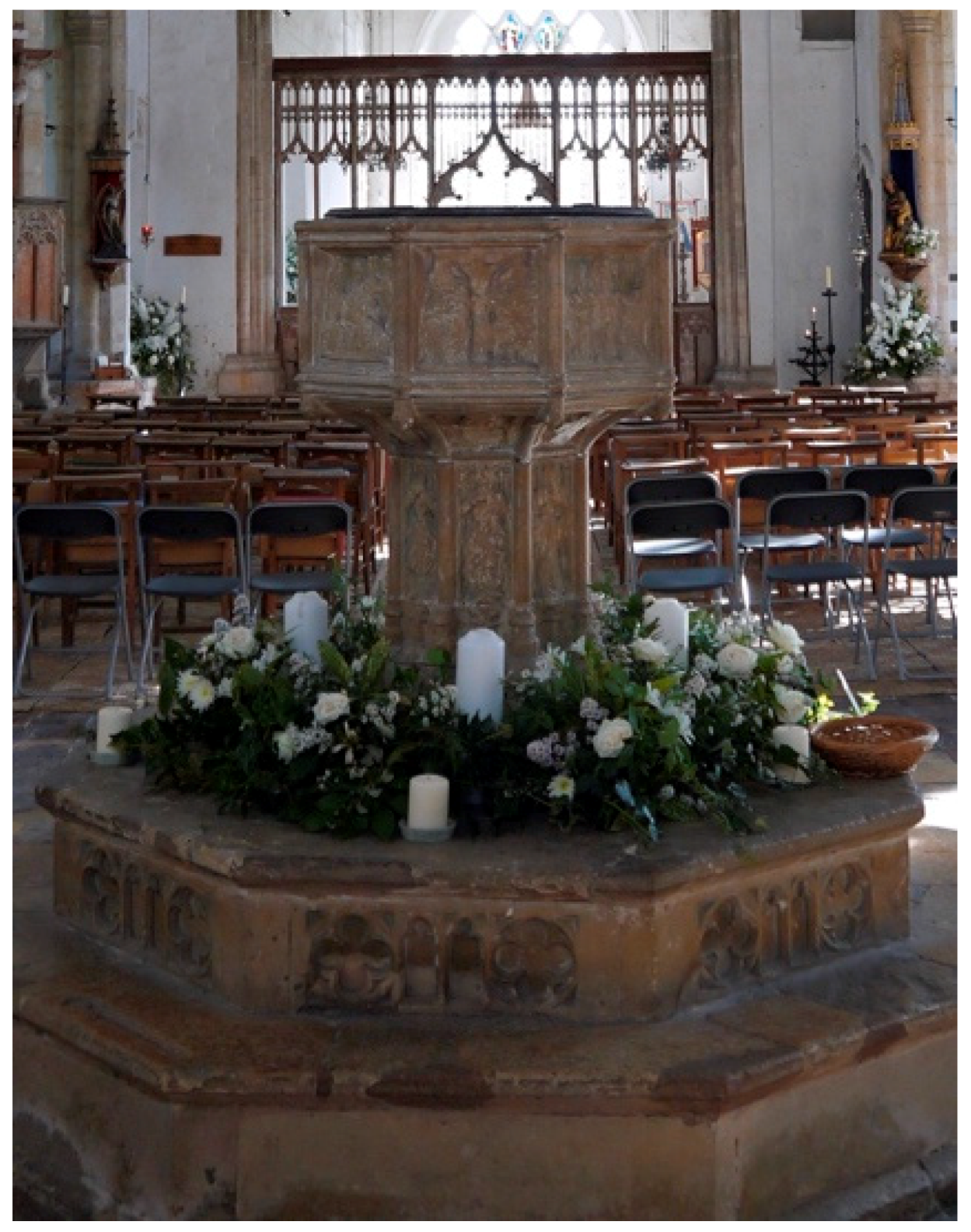

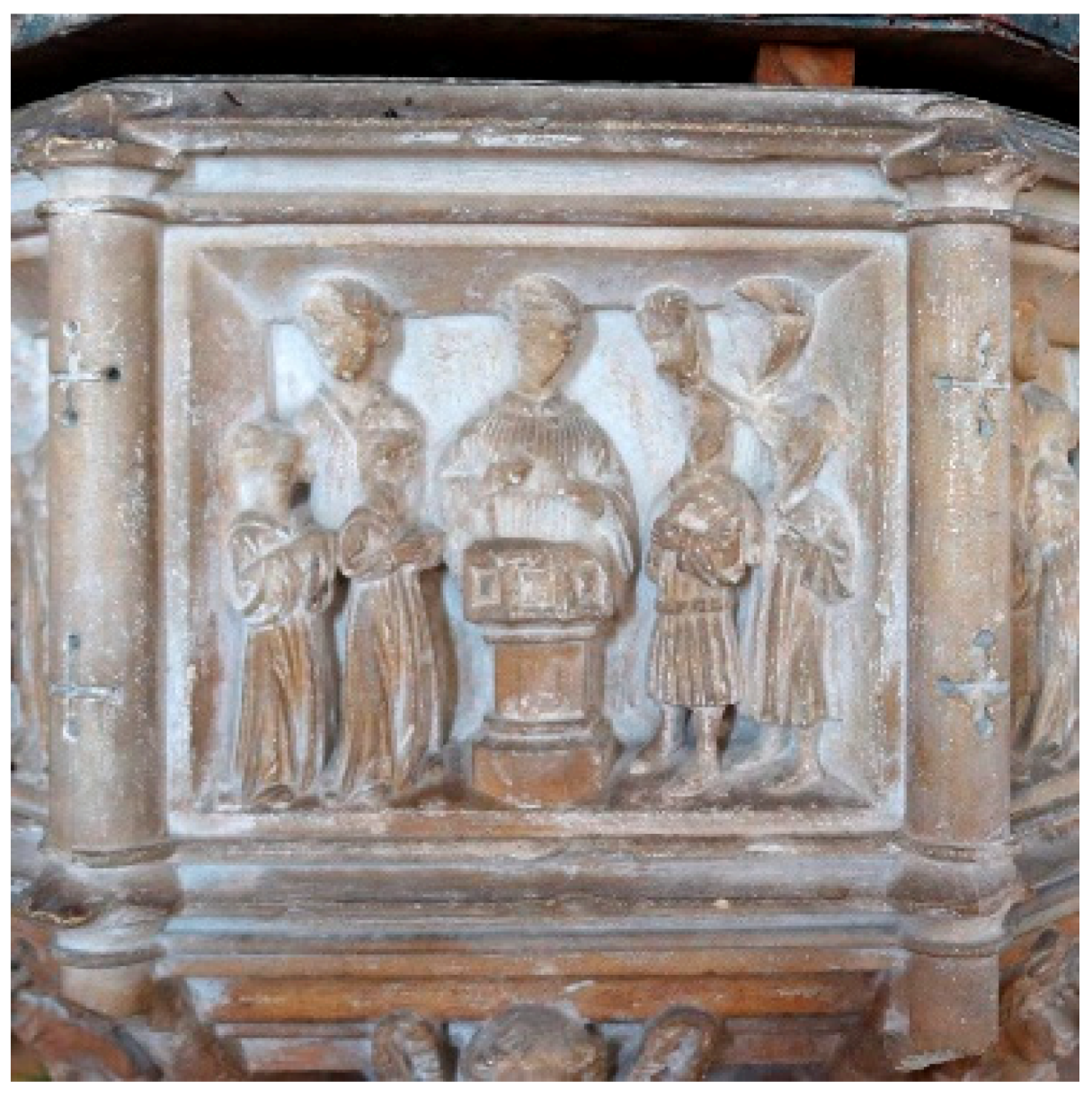
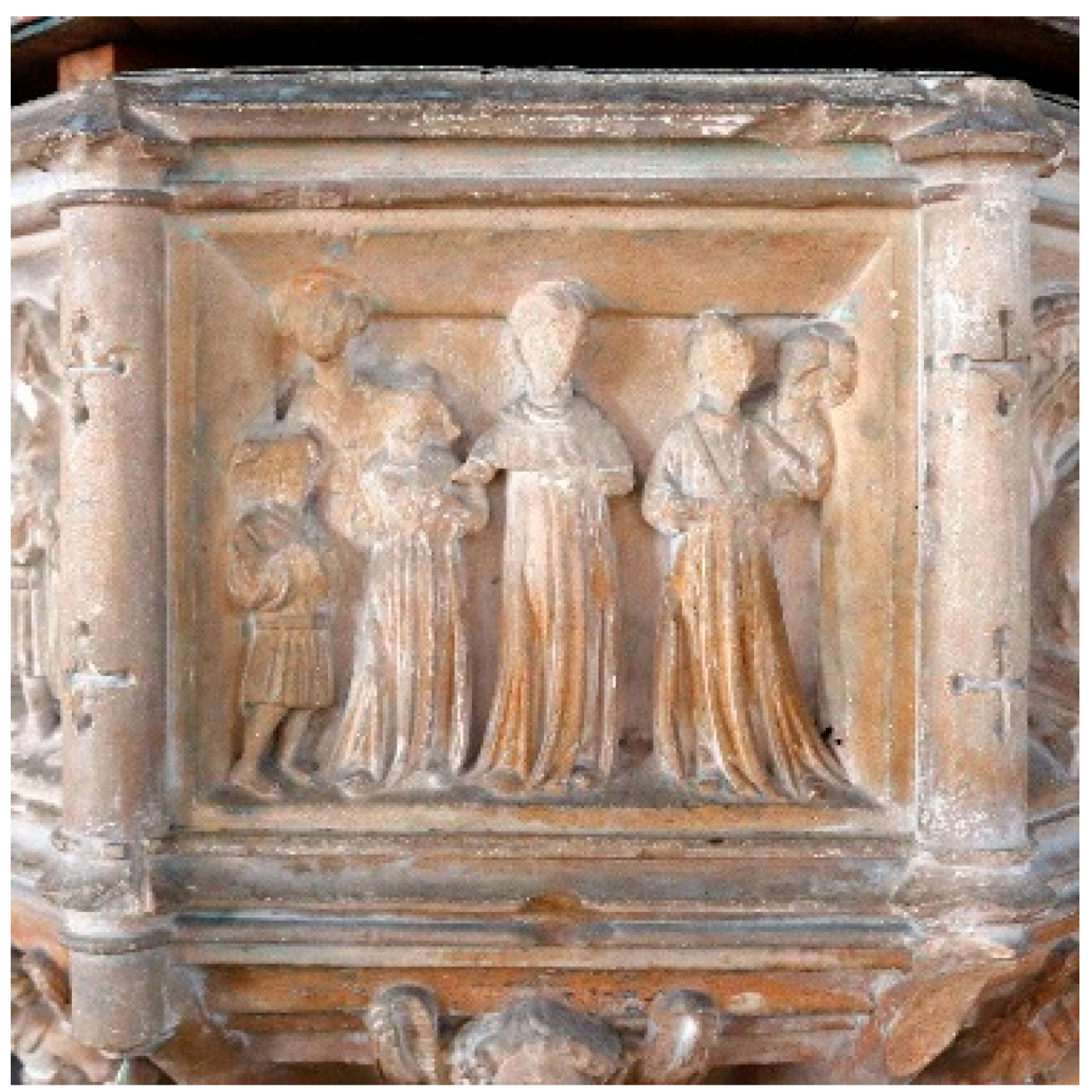
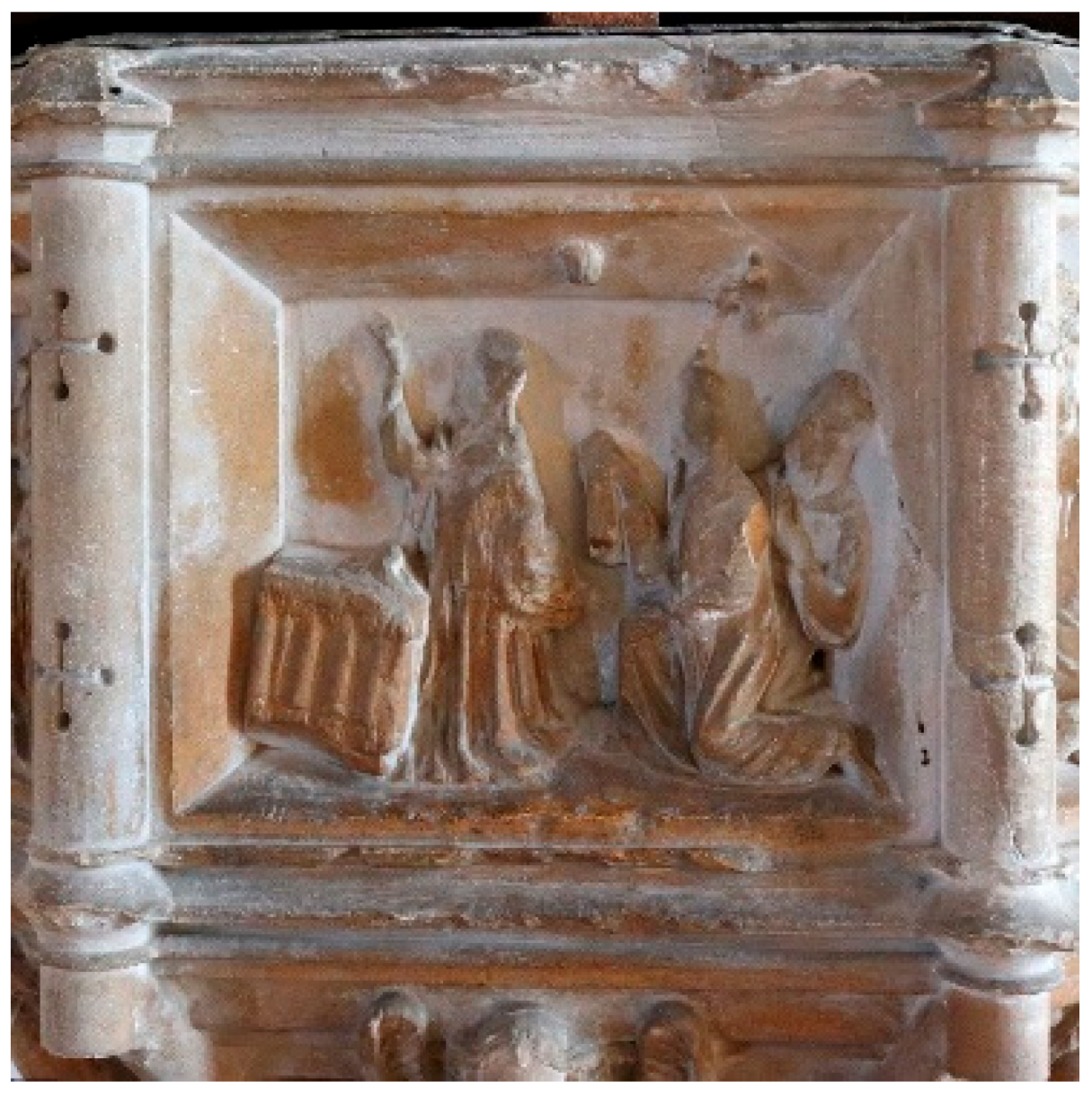
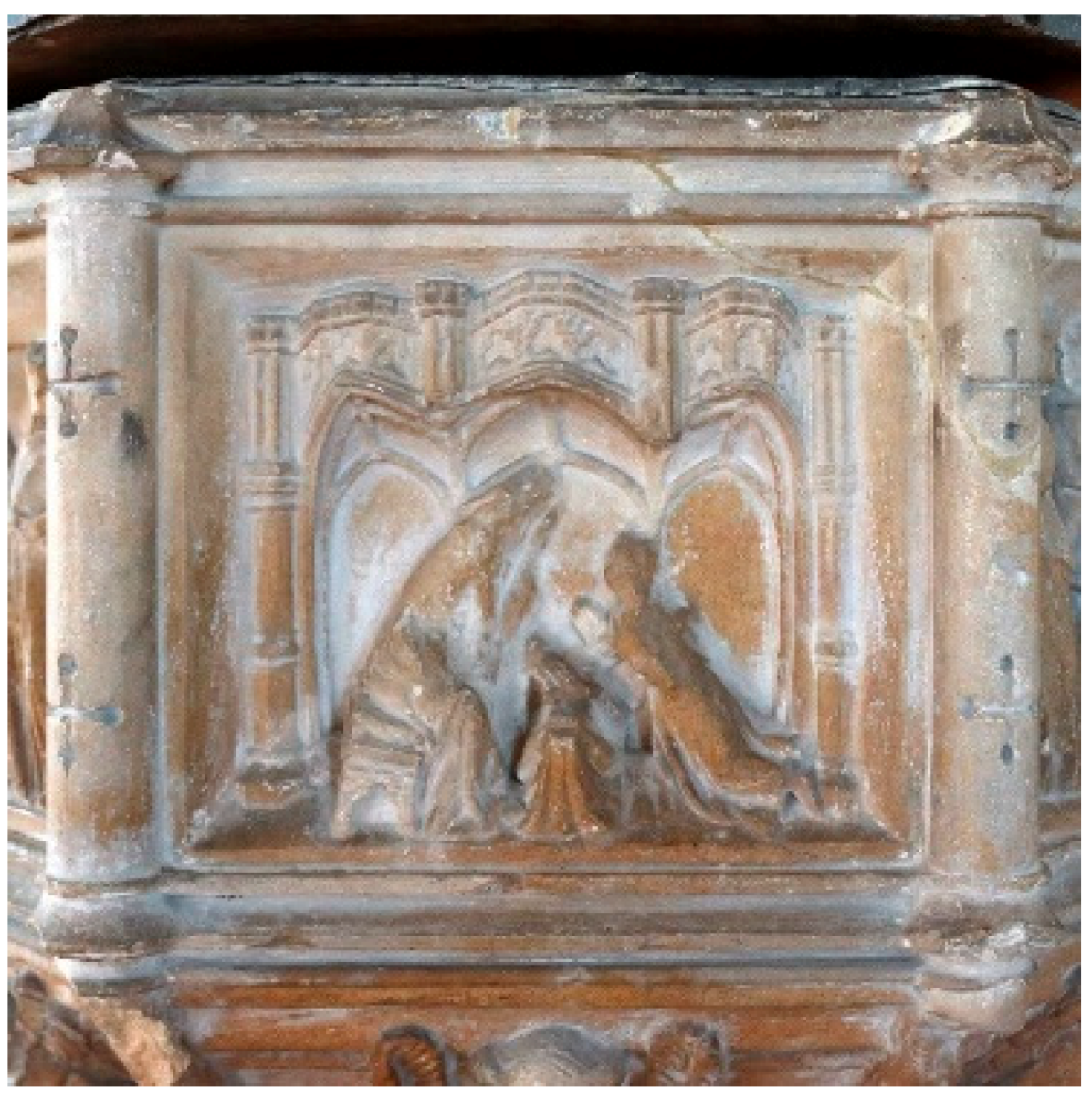
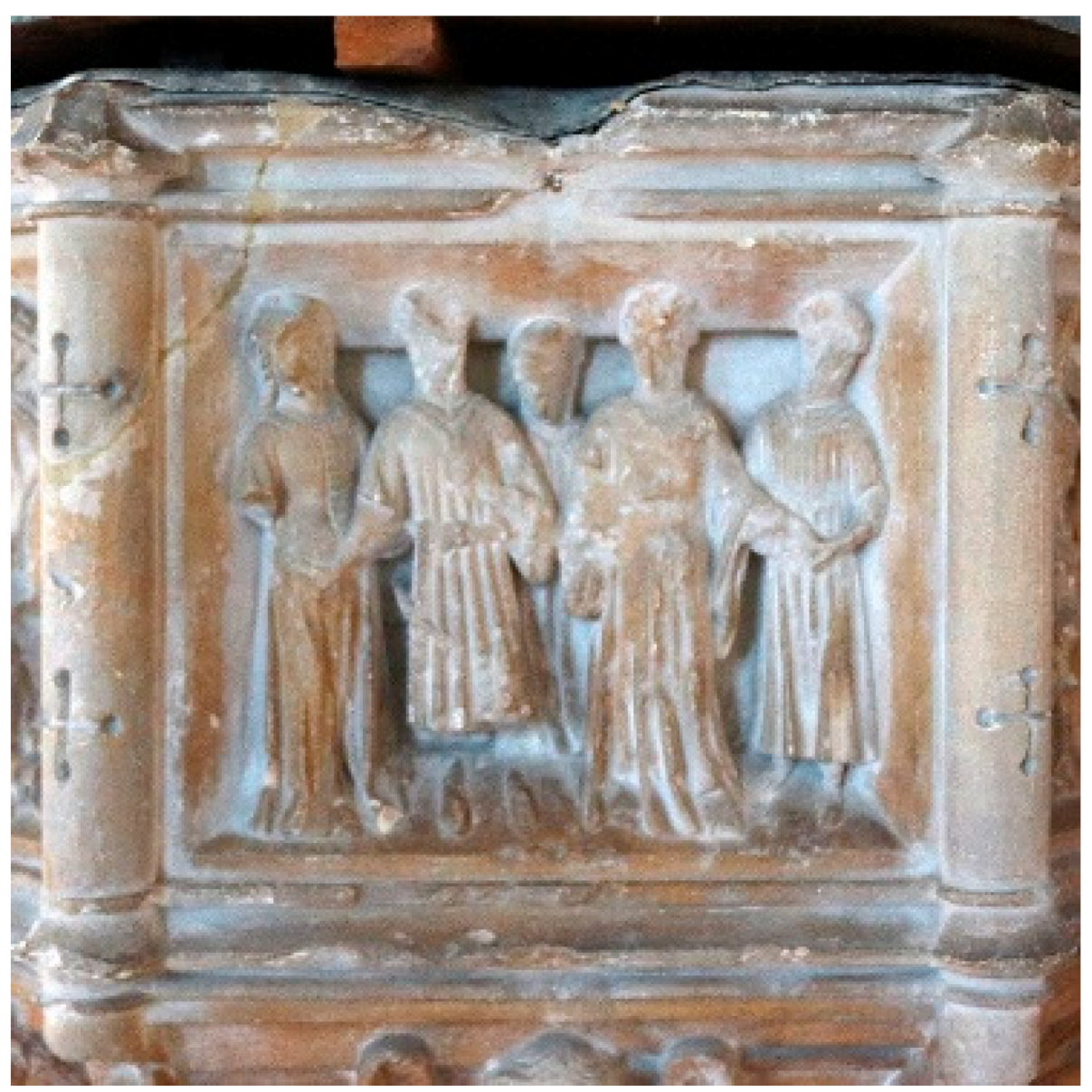

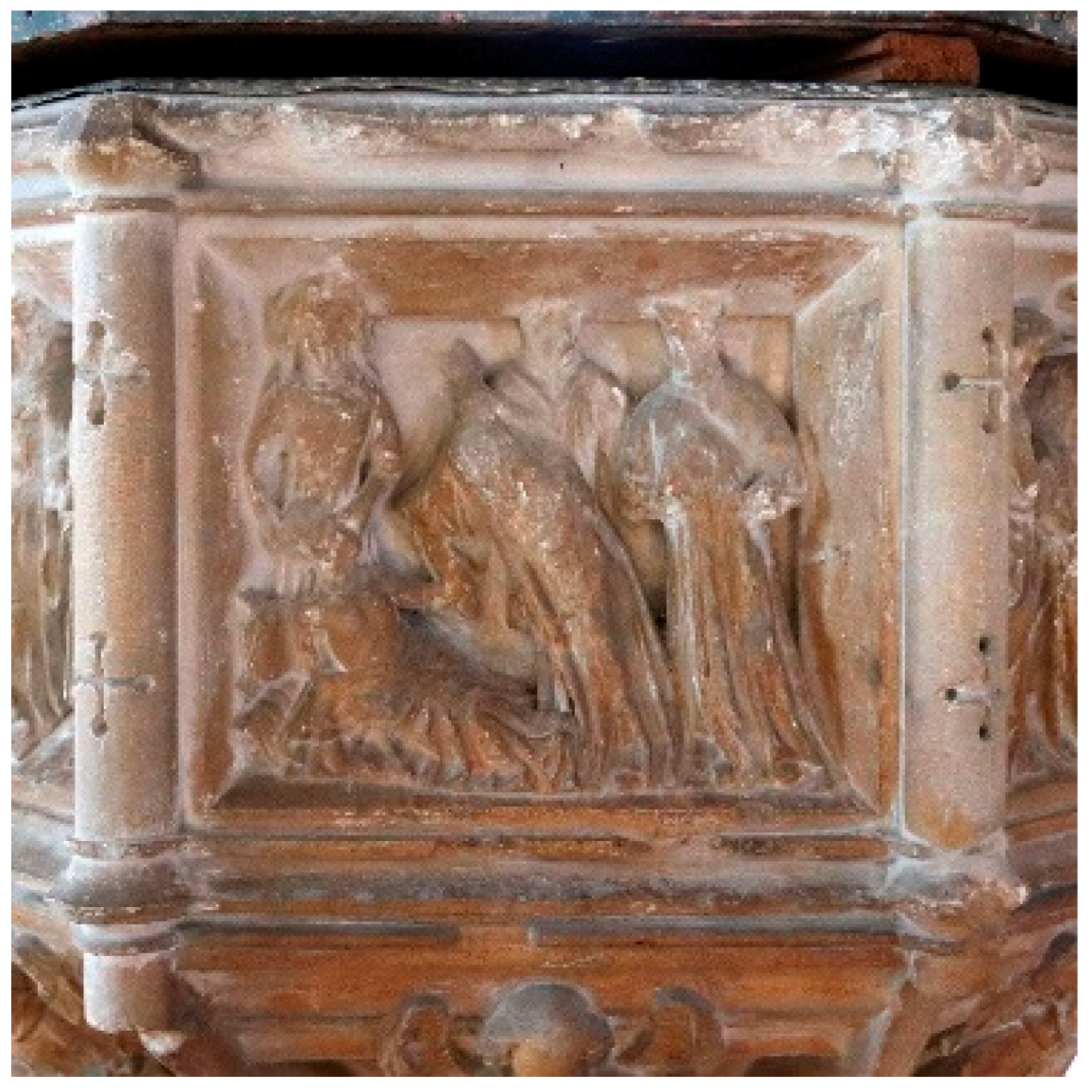
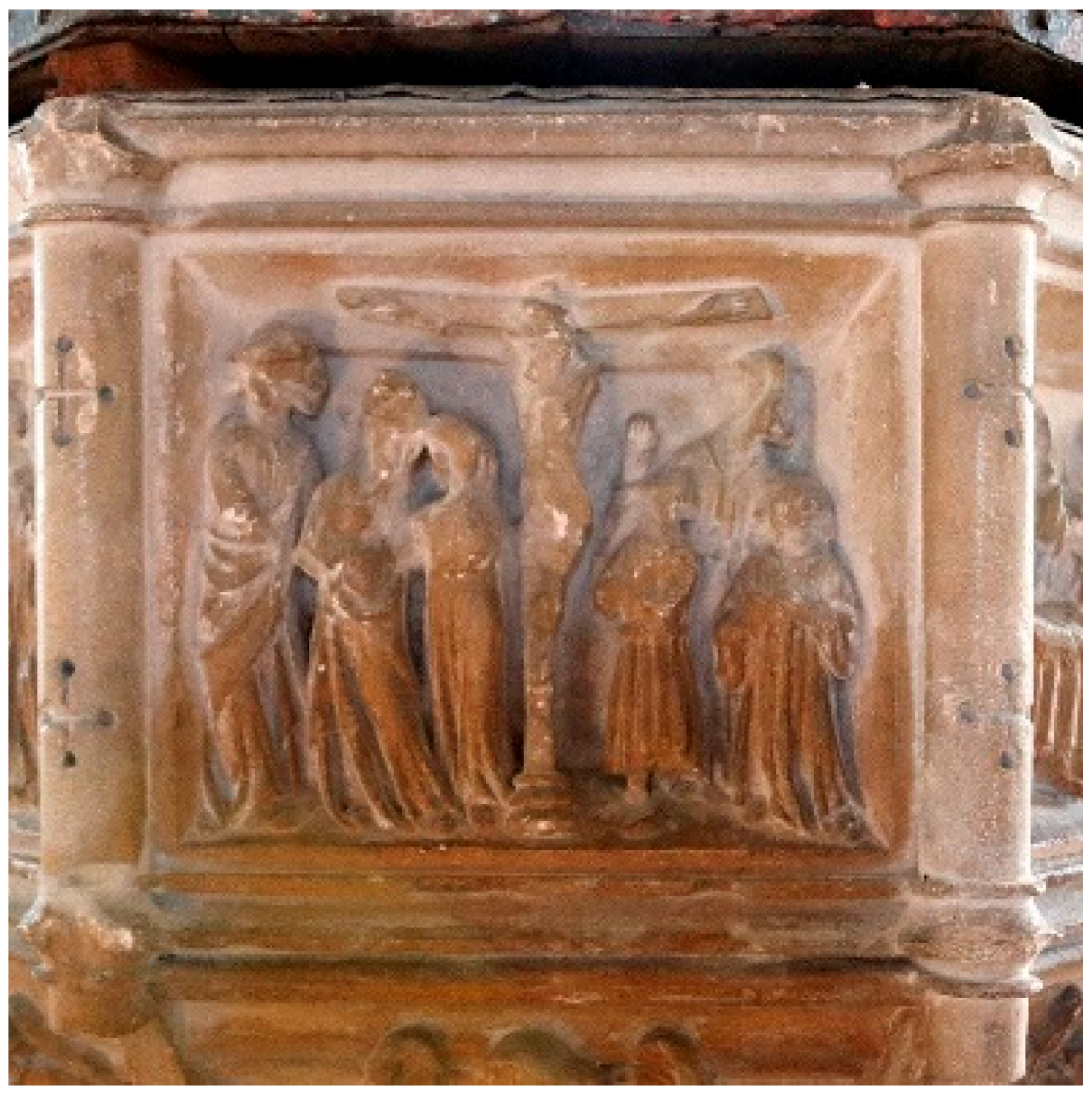
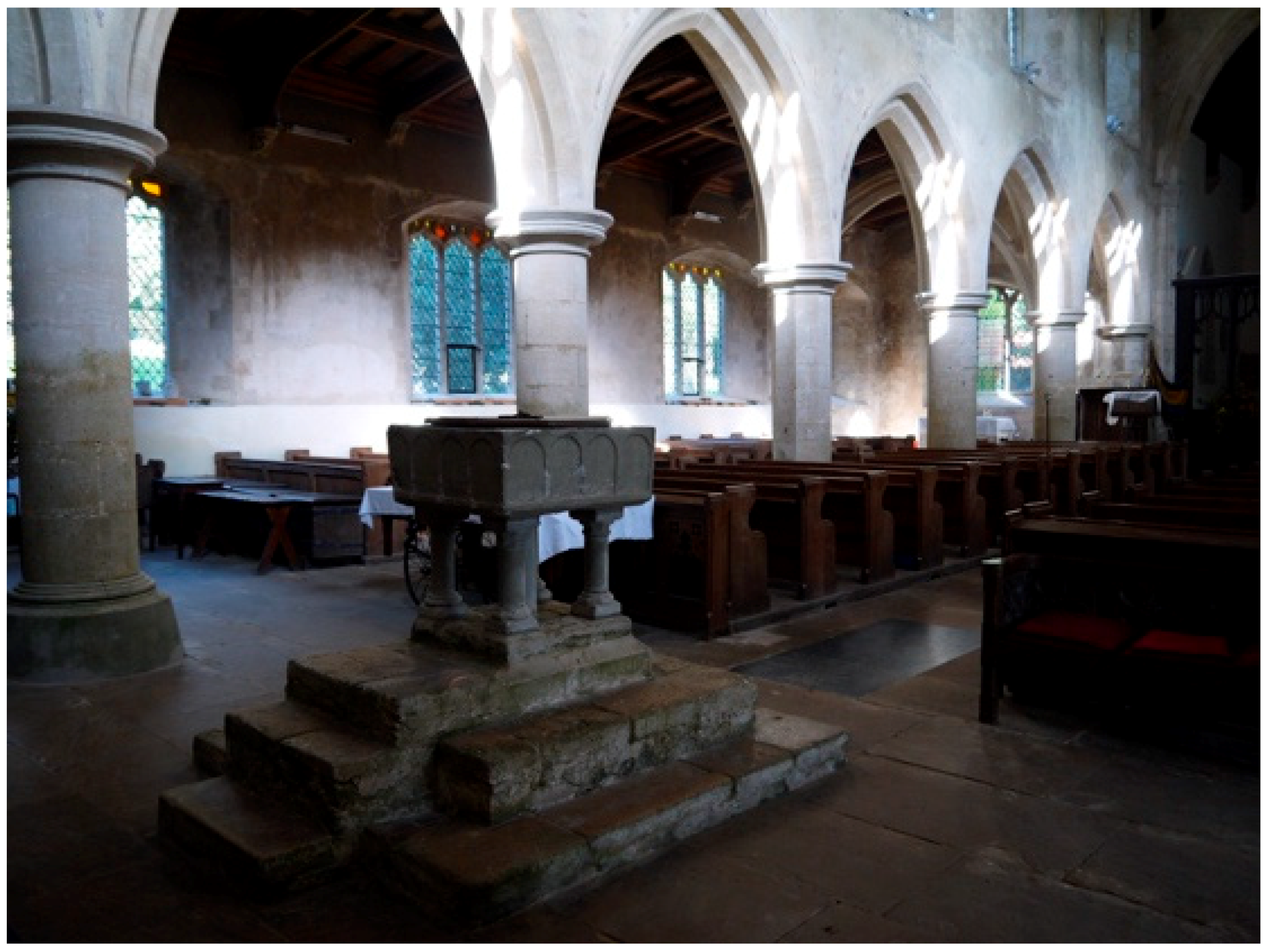
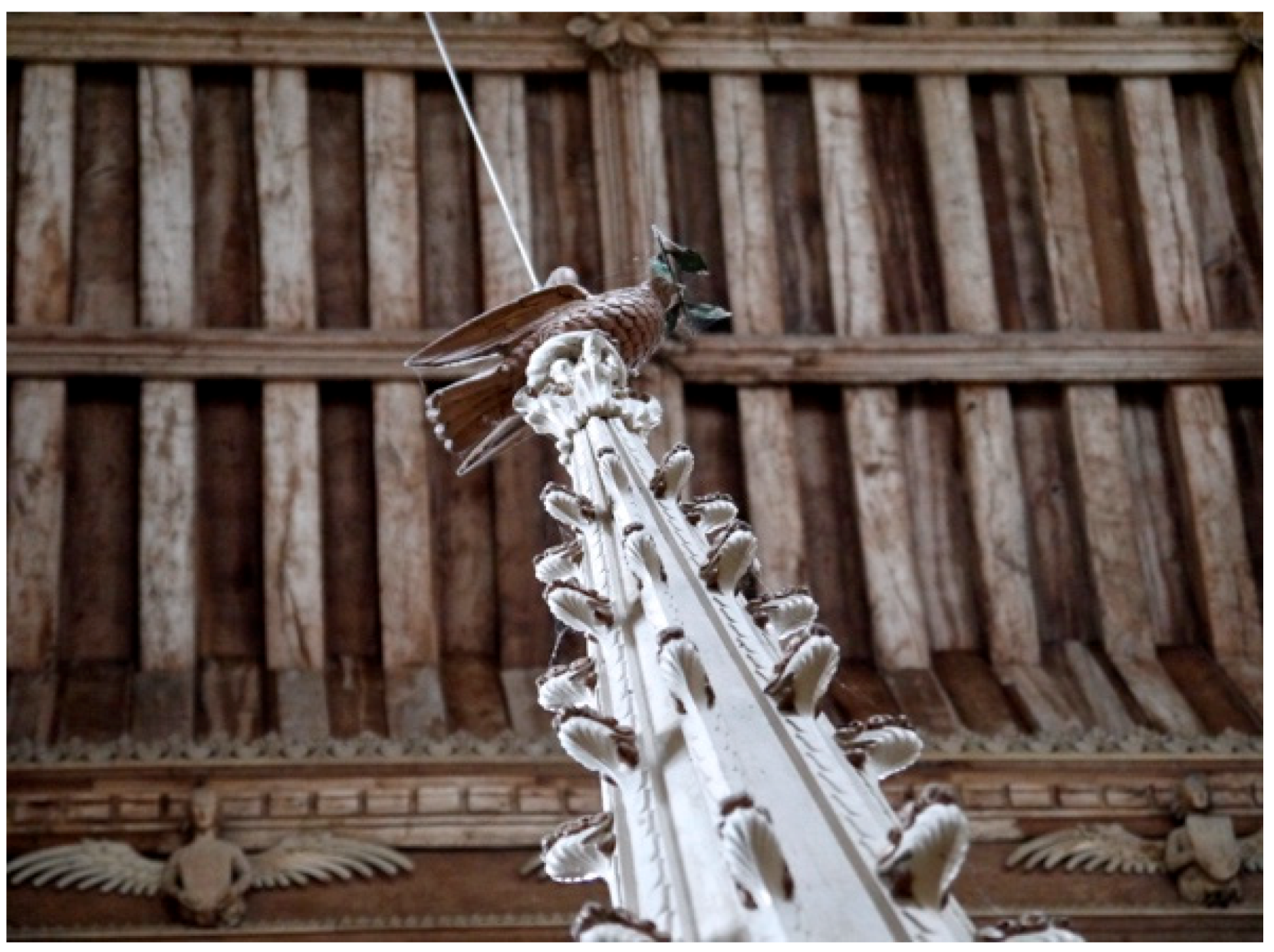

Publisher’s Note: MDPI stays neutral with regard to jurisdictional claims in published maps and institutional affiliations. |
© 2021 by the author. Licensee MDPI, Basel, Switzerland. This article is an open access article distributed under the terms and conditions of the Creative Commons Attribution (CC BY) license (https://creativecommons.org/licenses/by/4.0/).
Share and Cite
Clausén, M. “‘But the Fountain Sprang Up and the Bird Sang Down’: Heidegger’s Gathering of the Fourfold and the Seven-Sacraments Font at Salle, Norfolk.”. Religions 2021, 12, 464. https://doi.org/10.3390/rel12070464
Clausén M. “‘But the Fountain Sprang Up and the Bird Sang Down’: Heidegger’s Gathering of the Fourfold and the Seven-Sacraments Font at Salle, Norfolk.”. Religions. 2021; 12(7):464. https://doi.org/10.3390/rel12070464
Chicago/Turabian StyleClausén, Marie. 2021. "“‘But the Fountain Sprang Up and the Bird Sang Down’: Heidegger’s Gathering of the Fourfold and the Seven-Sacraments Font at Salle, Norfolk.”" Religions 12, no. 7: 464. https://doi.org/10.3390/rel12070464
APA StyleClausén, M. (2021). “‘But the Fountain Sprang Up and the Bird Sang Down’: Heidegger’s Gathering of the Fourfold and the Seven-Sacraments Font at Salle, Norfolk.”. Religions, 12(7), 464. https://doi.org/10.3390/rel12070464




